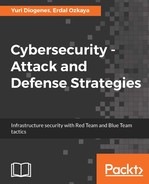Vulnerability assessment closely follows risk assessment in the vulnerability management strategy. This is because the two steps are closely related. Vulnerability assessment involves the identification of vulnerable assets. This phase is conducted through a number of ethical hacking attempts and penetration tests. The servers, printers, workstations, firewalls, routers, and switches on the organizational network are all targeted with these attacks. The aim is to simulate a real hacking scenario with the same tools and techniques that a potential attacker might use. The majority of these tools were discussed in the reconnaissance and compromising the system chapters. The goal in this step is not only to identify the vulnerabilities but also to do so in a fast and accurate manner. The step should yield a comprehensive report of all the vulnerabilities that an organization is exposed to.
The challenges faced in this step are many. The first one to consider should concern what the organization should assess. Without an appropriate asset inventory, an organization will not be able to identify which devices they should focus on. It will also become easy to forget to assess certain hosts, and yet they may be key targets for potential attack. Another challenge has to do with the vulnerability scanners used. Some scanners provide false assessment reports and guide the organization down the wrong path. Of course, false positives will always exist, but some scanning tools exceed the acceptable percentage and keep on coming up with nonexistent vulnerabilities. These may lead to the wasting of the organization's resources when it comes to mitigations. Disruptions are another set of challenges that are experienced at this stage. With all the ethical hacking and penetration-testing activities going on, the network, servers, and workstations suffer. Networking equipment such as firewalls also get sluggish, especially when denial of service attacks are being carried out.
Sometimes, strong attacks will actually bring down servers, disrupting core functions of the organization. This can be addressed by conducting these tests when there are no users using them, or coming up with replacements when core tools are being assessed. There is also the challenge of using the tools themselves. Tools such as Metasploit require you to have a solid understanding of Linux and be experienced with using command-line interfaces. The same is true for many other scanning tools. It is difficult to find scanning tools that offer a good interface and at the same time offer the flexibility of writing custom scripts. Lastly, sometimes scanning tools do not come with a decent reporting feature, and this forces the penetration testers to manually write these reports. Their reports may not be as thorough as those that would have been generated directly by the scanning tools.
